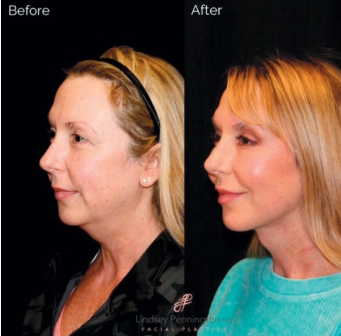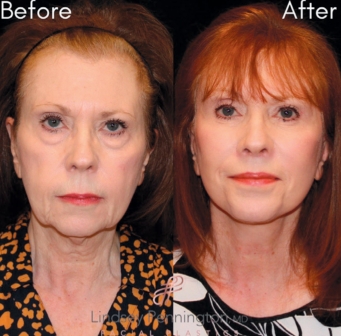Dealing with the Aging Face

Understanding cosmetic surgery
According to the American Society of Plastic Surgeons, facelifts (and neck lifts) were the number one requested surgical procedure in the head and neck region for 2022. It is also the most popular surgical procedure in my practice. A whopping 93% of patients on consumerdriven websites, like Realself, who have undergone a facelift rate it as worth it and would recommend it to a friend or family member. As a double boardcertified facial plastic surgeon specializing in cosmetic surgery of the face with a focus on addressing concerns of the aging face, I have a lot of experience in this area.
A facelift, medically known as a rhytidectomy, helps address facial aging associated with sagging, loose skin. The age of patients who consult me varies widely, but most commonly, women in their mid-40s really begin to take note of the natural changes in their appearance. In the last 10 years, I have seen many advances in the surgical techniques of face and neck lifts. Results now more than ever are natural looking and lasting longer. These techniques, such as the extended deep plane facelift and structural neck lifts, in the hands of a skilled surgeon, are leaving patients refreshed and youthful with minimal downtown.
The most common questions I get asked from patients curious about face and neck lifts:
1) What is the downtime?
Every surgeon has different “rules” after surgery, and I am constantly researching ways to get you back to your daily activities faster. I have found meticulous surgical technique, sleeping upright in a recliner, eating a lowsalt, low-inflammatory diet, and doing hyperbaric oxygen treatments (I have a chamber in my office specifically for my post-op patients) have helped dramatically minimize downtime and decrease any signs of swelling and bruising. I tell my patients 55 and younger they can be back to work in two weeks; over 55, I recommend part-time light duty that third week back to work just because those patients seem to have more fatigue and are still recovering.
2) Does it hurt?
Over 90% of my patients do not take narcotic pain medications during recovery. I prescribe a combination of anti-inflammatory and muscle relaxation medications,
which keep patients comfortable. Every patient is different, though,
and each treatment plan is tailored to make every patient comfortable.
3) I don’t want to look crazy: I get many mentions of Joan Rivers and Kenny Rogers.
 I
don’t want my patients to look crazy, either. That is why it is so
important when interviewing surgeons to research them and ask to see
their public and private before and after pictures. Importantly, look
for ones who have similar anatomy to you. A correctly done facelift
should help you look like you but 10-15 years younger. My patients bring
pictures of themselves 15 years before, where they are now and when
they were in their early 20s. It helps us have a better discussion of
their anatomy and their goals. You should look refreshed and natural
when done. The more advanced techniques can also help prevent facial
sweeps or the unnatural looks seen in the past when lips get stretched
or pulled out wide.
I
don’t want my patients to look crazy, either. That is why it is so
important when interviewing surgeons to research them and ask to see
their public and private before and after pictures. Importantly, look
for ones who have similar anatomy to you. A correctly done facelift
should help you look like you but 10-15 years younger. My patients bring
pictures of themselves 15 years before, where they are now and when
they were in their early 20s. It helps us have a better discussion of
their anatomy and their goals. You should look refreshed and natural
when done. The more advanced techniques can also help prevent facial
sweeps or the unnatural looks seen in the past when lips get stretched
or pulled out wide.
4) What are the differences among all the different types of facelifts?
As a patient, it’s not your job to know everything medical or to tell your surgeon what type of facelift to do. That said, not all facelifts, and not all surgeons, are created equal. Your job is to know the surgeon’s history regarding training, post-training education and experience, and most importantly, pictures of their work. It is also essential to make sure you are comfortable with the communication. Did they sit down and spend the appropriate amount of time to get to know you and your goals and explain the whole process? It is a huge decision to let someone operate on your face, and it can be a big financial commitment. It should not be taken lightly.
Here is a quick rundown of the differences:
Mini-facelift: Same incisions as a traditional facelift, but minimal dissection to remove just a small amount of skin. It is suitable for young patients with slight laxity and no need to lift the cheek or neck area.
Plication/imbrication facelift: Dissects skin further than a mini-facelift, folds the deeper structures with a suture and focuses on the lower face area. Inconspicuous incisions are made around the hairline and the ears. The surgeon separates the top layer of skin from the muscles and tissues underneath. Excess skin is cut out and removed, and discarded. The remaining skin is stretched all the way to the incision areas. This is good for patients with deep-set wrinkles without much skin laxity.
Deep plane facelift: Avoids the problem of the tight, swept, overfilled look of many facelifts. The main goal of the deep plane facelift is to lift only under the muscle layer, leaving the skin attached to the muscle layers so that it never looks too tight. It also lifts the cheeks by releasing the tethering points of the face in the deep plane so that adding fat or filler is unnecessary. With a deep plane lift, this cheek lift is unmatched. When specifying deep plane facelift, that approval rating climbs to an impressive 97% “worth it” rating from patients.
 Extended deep plane: Takes
the same surgical techniques of lifting the facial muscle layer (SMAS)
and extends that into the neck, leading to very aggressive results that
can definitively re-define the patient’s jawline and remove laxity with
natural results and longevity. Dr. Jacono in New York City has refined
and pioneered the popularity of this procedure. I am grateful to have
had the opportunity to observe him multiple times and get hands-on
training from him on refining this technique.
Extended deep plane: Takes
the same surgical techniques of lifting the facial muscle layer (SMAS)
and extends that into the neck, leading to very aggressive results that
can definitively re-define the patient’s jawline and remove laxity with
natural results and longevity. Dr. Jacono in New York City has refined
and pioneered the popularity of this procedure. I am grateful to have
had the opportunity to observe him multiple times and get hands-on
training from him on refining this technique.
Structural neck lifts are advanced ways to address the standard neck left. In addition to tightening the muscle layer of the neck, structures below this muscle layer, such as deep fat, salivary glands and digastric muscles, may need to be addressed due to a patient’s anatomy, weight gain or aging. I save this procedure for patients who need aggressive adjustments to help re-define their jawline and neck.
With many options available, it is usually not a one-size-fits-all; it’s patient, anatomy and goals dependent. Find a surgeon you trust, discuss all the options and find the best option for you.
5) What does a facelift cost?
This can widely be based on where you are located geographically, our surgeon’s experience, the techniques used, aftercare protocols, etc. Undergoing a face or neck lift isn’t something to be taken lightly, and it isn’t the time to bargain shop; it comes with risk and finding a safe, qualified surgeon, whom you communicate well with, trust, and who is going to deliver the results necessary to keep you looking natural and youthful should be the primary goal.
According to realself.com, for the region of Louisiana, pricing for surgical fees ranges from $12,000-$22,000, whereas in areas like Like Dallas, pricing can be in the range of $25,000- $40,000 and in New York City and St. Louis, surgeons are charging in the $100,000-$200,000 range.
Dr. Lindsey Pennington is a double board-certified facial plastic surgeon with an office at 6030 Line Ave. in Shreveport. She is the only female facial plastic and reconstructive surgeon in solo private practice in Louisiana. Dr. Pennington is known for her refined, natural results. All cosmetic consults are complimentary. Website: www.penningtonfacialplastics.com or Phone (318) 216- 5366. Follow them on FB and IG @penningtonfacialplastics for special offers and examples of their work.
